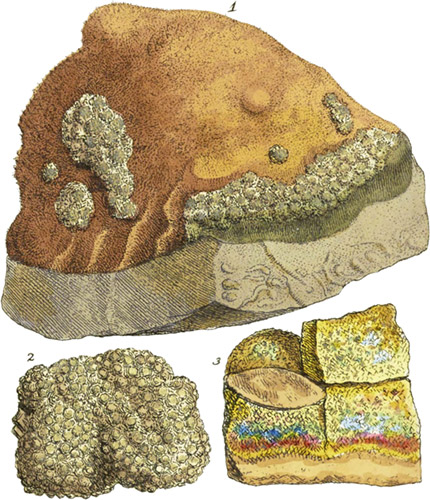 Enlarge
Enlarge
British Mineralogy
Mammillated Sulphuret of Iron
In common every discoverer of this very pretty attractive substance becomes elate at the idea of having found Silver or Gold; some means of undeceiving such, with other useful information concerning it, should not be overlooked.
I have Shown some varieties of pyrites already in this work; the present specimens, however, are somewhat instructive as well as pretty. Fig. 1 is from Highgate Tunnel, it is part of a Clay marle septarium, covered for the most part with waxy brown spiculæ of Carbonate of Iron, with various little masses of the pyrites, which have a blistered appearance and are of a bright silvery lustre, mostly composed of very small smooth faces of cubes or cuho-oetaëdrons, (highly resembling such as are found more solid in the Cornish Copper mines, see fig. 2.); the base shows the marly clay outside, and a few marks, caused, probably, by some animal remains, Fig. 3 represents a few septa of a small specimen with iridescent pyrites, mostly inclining to octaëdrons and more or less dull, spread over the surface of every interstice, probably as deposited by water; even a bit of a Crab’s claw is included. The beautiful brilliancy of the original must be conceived in a great measure, as it could not be equalled, yet the information I believe will not be misunderstood. This specimen was more ochraceous in the tint of the Clayey marie. Pyrites such as these seem to occur every where, even in primitive mountains. The Cornish ones are apt to decay, as do some of those from Highgate.

